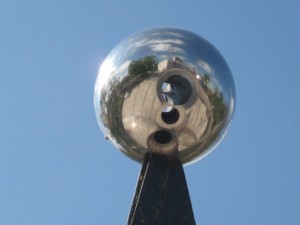At 11:47 am Central Time on Monday, December 21, the sun is overhead at the Tropic of Capricorn. This is the farthest point south at which the sun can be overhead, indicating that the North Pole is tilted as far away from the sun as possible. At the Tropic of Capricorn and elsewhere in the Southern Hemisphere, the high sun results in the longest day of the year and the beginning of summer. Up here in the Northern Hemisphere, however, the sun is as low as possible in the sky, and we have our shortest day of the year. This is the winter solstice for us.
Ancient peoples across America, Europe and Asia noticed that the sun got lower and lower and the daylight shorter and shorter throughout autumn. When the sun reached its lowest point, this meant that it had stopped going away and would return–a cause for celebration. One of the many pagan winter solstice festivals was Yule, celebrated in northern Europe. Another was the festival of Sol Invictus (the Unconquered Sun) celebrated in Rome on Dec. 25. Keep in mind that in antiquity the 25 was the date of the solstice itself–the sun which had stopped going away and begun to return was ‘unconquered.’ Due to the imprecision of the Julian calendar, the solstice had shifted to Dec. 21 by the year 325 A.D., when the Nicene Council convened. Since Pope Gregory’s reform was calculated to restore the equinoxes and solstices as of the Nicene Council, the winter solstice is now on Dec. 21 (occasionally Dec. 22).
No one in antiquity knew what date Jesus was born. For one thing, many of the early Christians rejected all birthday celebrations of any kind as a pagan ritual. Even had folks wanted to observe Jesus’ birth, the lunar calendar used in Israel at the time would complicate the choice of date. The Chronology of 354 is the oldest document to list Christmas as a festival. When the church selected Dec. 25 for this festival, it was probably because late December was already a festive time across the Roman Empire.
 |
 photo credit: kevindooley photo credit: kevindooley |
Although today is the shortest day of the year, you may have already noticed that sunset is a few minutes later now than at the beginning of the month. In June, the North Pole was tilted towards the sun as much as possible. Since then, the North Pole has tilted a little more away from the sun each day. Days have been getting shorter because each day the sun has taken a slightly lower path across the sky. Sunrises have been getting earlier and sunsets have been getting later. By late November the sun had already gotten about as low as it is now. As the day to day difference in the sun’s height gets smaller, another effect begins to dominate.
Earth’s orbit is not a circle; it is an ellipse. The orbit is almost a circle, however; the eccentricity (out-of-roundness) is just 0.016, where 0 is a perfect circle and 1 a parabola. This is enough of a difference to bring Earth slightly closer to the sun in early January and take it slightly farther away in early July. Therefore, Earth is now beginning to make its closest approach to the sun (called perihelion). As a result, Earth is speeding up on its orbit. This causes sunrise, local noon, and sunset to occur just a little later each day. By the 21, sunset will occur at 5:27 pm, as opposed to 5:22 pm on Dec. 2 (the actual date of the earliest sunset). Sunrise, however, will have shifted from 7:00 am to 7:13 am. Thus, that days are still getting shorter even though the sunsets are a little later.
Many people assume that the winter solstice should be the coldest day, but this is usually not true. January is usually colder. Although days get a little bit longer and the sun a little bit higher beginning Monday, it takes quite awhile for this to add up to an appreciable difference in the Sun’s height in the sky and in the amount of light and heat reaching the arctic. Frigid air masses continue to form in the arctic and move across the Northern Hemisphere throughout January, February, and often March. Although the sun is higher in those months than in December, the air can be just as cold if not colder.

Hopefully, we are getting all of our cloudy, gloomy weather over with , and the solstice will be sunnier. If so, you can join us on the museum sundial at noon on Monday, Dec. 21 to observe the sun! This is one of the Fun Hundred events celebrating our 100 anniversary here at the Museum. On top of the gnomon on our sundial is a silver ball with three sets of holes, which allows the sun to shine through pairs of lenses near each solstice or equinox. To account for cloudy weather, our gnomon’s holes are big enough that the sun aligns with them for a few days before and after the exact equinox or solstice date. The holes aligned with the winter solstice are so big that you can still project the sun’s image through them deep into January! If the weather does not cooperate Monday, you can come and observe the sun on our sundial near noon on any day in the next few weeks.